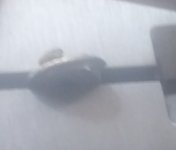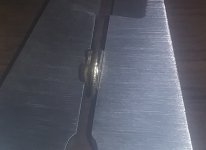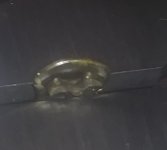I don't understand how depth can be the problem. The primer pocket had a fully seated primer previously. How could the depth become less?
It is not necessarily the pocket depth. There are other variables:
1. Primers in the tray are x high from legs to top.
2. Primers seated properly (below the case head) are x - y high, where y is the compression of the primer assembly when seating.
3. Each new primer is compressed this way in seating. Not seating primers deeply enough is a common mistake, and cause Failure-to-Fire (FtF) as the firing pin energy is used up pushing the improperly seated primer to its proper position.
4. Your HIGH primer in the photo is nothing but trouble. I would deprime and discard the primer, and move the brass into your fired range brass bucket (until after you master case prep).
So, yes, clean primer or uniform primer pockets, if for no other reason than you will be sure that is not an issue.
I think the problem is with the primer pockets that have a crimp. If they are not "un-crimped" enough it takes a lot of force to get them in.
That is a "show-stopper". It is a problem you must stop at this point and completely address that issue, before doing anything else. I would say not processing crimped primer pockets is YOUR ONLY Problem at this point. Downstream, primers may not seat, etc., because of this issue.
Search on Google, or even this forum, for procedures to process military (crimped) brass. You may also need to measure and possibly trim your brass length; some calibers more than others. Sizing military brass can also be difficult, or complicated (multiple steps and sizing dies).
But then again I may not know what I'm talking about.
Search, find and read articles about handling military brass.
Then seriously consider the option of purchasing quality new brass like Starline, or Winchester, rather than buying specialized tools and learning skills that are not much fun. Starline has 5.56 new uncrimped brass: 500 for $119.50 shipped. Their 223 Rem. is a little cheaper at $116.50, but is out of stock.
https://www.starlinebrass.com/556x45mm-brass
"The 5.56x45mm NATO is the military version of the .223 Remington, which is one of the most widely used centerfire cartridges today. Starline’s 5.56x45mm brass is identical to Starline’s .223 Remington brass except for a slight change in the metallurgy making it harder at the base of the case."
SEMANTICS
I am suggesting that you hit the books. Reloading manuals, and specifically, good detailed ones. Here is a link to Western Powders Reloading guide. In addition to load data, this latest version includes fair reloading process text, and a photo of a real flattened primer (p.12 bottom).
http://www.accuratepowder.com/wp-content/uploads/2018/11/WPHandloading-Guide-7.0-Web-REV.pdf
Your specific focus should be on brass preparation, priming, and inspecting fired primers for pressure signs. When you started with "flattened primers" you were using reloading jargon for post-firing primer inspection. Everyone thought that was what you were talking about; but, you were not. Your photo of unfired primers, one dimpled (I do that in hand primer devices, not an issue), one WAY TOO HIGH, and needs to be triaged, issue identified, and remediated before moving to any other step. I suggest that you should be aware of this jargon and know how to use, and when not to use it. That could have been avoided entirely, if the picture was in your FIRST post.
Discussion of actual "flattened primers" is actually outside the scope of the OP's thread and query.
This bit, and photos, was sarcastic humor. This primer is flattened. However, these are not photos of what reloaders call "flattened primers".
You call that a flattened primer?!?
Now here is what I call a flattened primer:
[I had benefit of the cooperation of a handy sledge hammer and improvised anvil. It took a pretty good wallup to get it that way. It was a CCI #34. I was expecting to get it thinner. They are pretty tough.]



